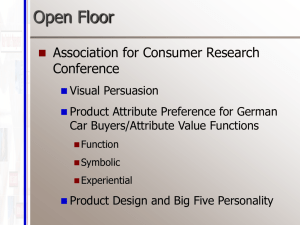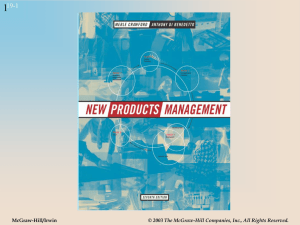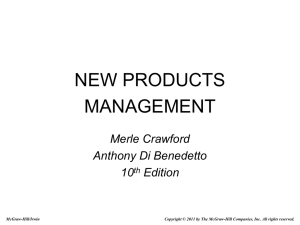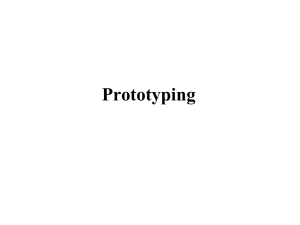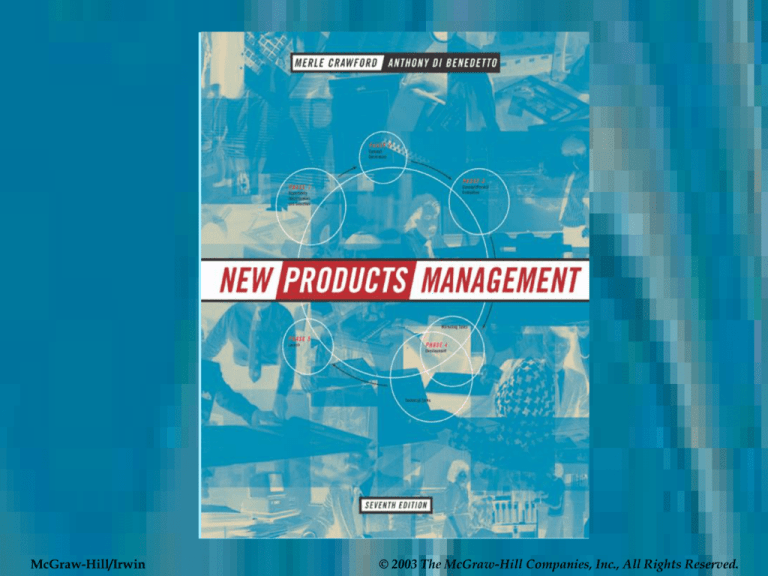
12-1
McGraw-Hill/Irwin
McGraw-Hill/Irwin
Copyright
© 2003 by The
McGraw-Hill Inc.,
Companies,
Inc. All Reserved.
rights reserved.
© 2003 The
McGraw-Hill
Companies,
All Rights
22-2
CHAPTER TWO
THE NEW PRODUCTS
PROCESS
32-3
The Basic New Product Process
Phase 1: Opportunity Identification/Selection
Phase 2: Concept Generation
Phase 3: Concept/Project Evaluation
Phase 4: Development
Phase 5: Launch
Figure 2-1
42-4
Phase 1: Opportunity
Identification/Selection
Active and passive generation of new product
opportunities as spinouts of the ongoing business
operation. New product suggestions, changes in
marketing plan, resource changes, and new
needs/wants in the marketplace. Research, evaluate,
validate, and rank them (as opportunities, not specific
product concepts). Give major ones a preliminary
strategic statement to guide further work on it.
52-5
Activities that Feed Strategic Planning for
New Products
• Ongoing marketing planning (e.g., need to
meet new aggressive competitor)
• Ongoing corporate planning (e.g., senior
management shifts technical resources from
basic research to applied product development)
• Special opportunity analysis (e.g., a firm has
been overlooking a skill in manufacturing
process engineering)
62-6
Sources of Identified Opportunities
• An underutilized resource (a manufacturing
process, an operation, a strong franchise)
• A new resource (discovery of a new material
with many potential uses)
• An external mandate (stagnant market
combined with competitive threat)
• An internal mandate (new products used to
close long-term sales gap, senior management
desires)
72-7
Phase 2: Concept Generation
Select a high potential/urgency opportunity, and begin
customer involvement. Collect available new product
concepts that fit the opportunity and generate new
ones as well.
82-8
Phase 3: Concept/Project Evaluation
Evaluate new product concepts (as they begin to come
in) on technical, marketing, and financial criteria.
Rank them and select the best two or three. Request
project proposal authorization when have product
definition, team, budget, skeleton of development
plan, and final PIC.
92-9
Stages of Concept/Project Evaluation
•
•
•
•
Screening (pretechnical evaluation)
Concept testing
Full screen
Project evaluation (begin preparing product
protocol)
The first stages of the new products process are sometimes
called the fuzzy front end because the product concept is
still fuzzy. By the end of the project, most of the fuzz should
be removed.
2-10
10
Phase 4: Development (Technical Tasks)
Specify the full development process, and its
deliverables. Undertake to design prototypes,
test and validate prototypes against protocol,
design and validate production process for the
best prototype, slowly scale up production as
necessary for product and market testing.
2-11
11
Phase 4: Development (Marketing Tasks)
Prepare strategy, tactics, and launch details for
marketing plan, prepare proposed business plan
and get approval for it, stipulate product
augmentation (service, packaging, branding,
etc.) and prepare for it.
2-12
12
Phase 5: Launch
Commercialize the plans and prototypes from
development phase, begin distribution and sale of the
new product (maybe on a limited basis) and manage
the launch program to achieve the goals and
objectives set in the PIC (as modified in the final
business plan).
2-13
13
The Impact of Simultaneous Operations on
the Product Development Process
Figure 2.2
2-14
14
The Life Cycle of a Concept
Figure 2-3
2-15
15
Rate of Use of NPD Steps among PDMA
Members
Figure 2-4
Concept searching
Concept screening
Concept testing
Business analysis
Product development (technical)
Use testing/market testing
90%
76%
80%
89%
99%
87%

